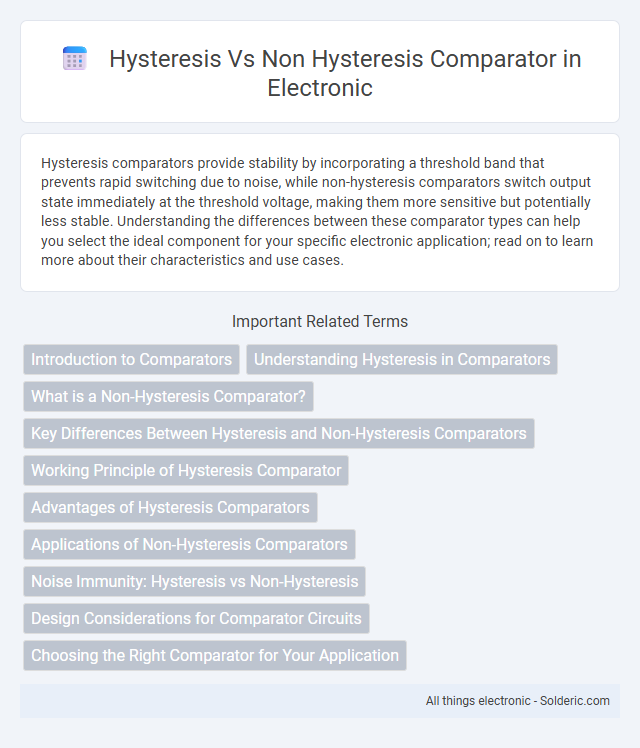Hysteresis comparators provide stability by incorporating a threshold band that prevents rapid switching due to noise, while non-hysteresis comparators switch output state immediately at the threshold voltage, making them more sensitive but potentially less stable. Understanding the differences between these comparator types can help you select the ideal component for your specific electronic application; read on to learn more about their characteristics and use cases.
Comparison Table
| Feature | Hysteresis Comparator | Non-Hysteresis Comparator |
|---|---|---|
| Definition | Comparator with two distinct threshold voltages (upper and lower) | Comparator with a single threshold voltage |
| Noise Immunity | High; reduces output oscillations due to noise | Low; prone to output chatter when input near threshold |
| Switching Behavior | Switches output state only when input crosses upper or lower threshold | Switches output immediately at threshold crossover |
| Applications | Signal conditioning, debouncing, and noisy input signals | Simple threshold detection in stable environments |
| Output Stability | Stable with minimal oscillation | May oscillate near threshold level |
| Example | Schmitt Trigger Comparator | Standard Comparator without hysteresis |
Introduction to Comparators
Comparators are essential analog devices used to compare two voltages and output a digital signal based on the comparison. Hysteresis comparators incorporate a small hysteresis voltage to prevent noise-induced oscillations around the switching threshold, enhancing stability in noisy environments. Non-hysteresis comparators lack this feature, making them suitable for applications requiring precise threshold detection without additional offset.
Understanding Hysteresis in Comparators
Hysteresis in comparators refers to the intentional introduction of a voltage difference between the switching thresholds to prevent rapid toggling caused by noise or slow input transitions, enhancing signal stability. Comparators with hysteresis, often implemented using positive feedback, create distinct upper and lower threshold voltages, ensuring the output changes state only when the input surpasses these defined levels. Non-hysteresis comparators switch output exactly when the input crosses a single threshold, making them more susceptible to noise-induced oscillations in the output signal.
What is a Non-Hysteresis Comparator?
A Non-Hysteresis Comparator is an electronic device that switches its output state immediately when the input voltage crosses a specific threshold, without any built-in delay or threshold difference between switching points. Unlike hysteresis comparators, which have two distinct threshold voltages to prevent rapid switching caused by noise or small fluctuations, non-hysteresis comparators respond strictly to a single reference voltage. Your choice of a non-hysteresis comparator is ideal for applications requiring sensitive and precise voltage level detection without the influence of output stability considerations.
Key Differences Between Hysteresis and Non-Hysteresis Comparators
Hysteresis comparators include a built-in feedback mechanism that creates two distinct threshold voltages, reducing noise sensitivity and preventing rapid switching, which is ideal for noisy or slowly varying signals. Non-hysteresis comparators have a single threshold voltage and switch output as the input crosses this point, making them more responsive but prone to unwanted oscillations in noisy environments. Understanding these key differences helps you select the appropriate comparator type based on your application's noise tolerance and accuracy requirements.
Working Principle of Hysteresis Comparator
A hysteresis comparator operates by incorporating positive feedback into the voltage comparator circuit, creating two distinct threshold voltages--one for switching from low to high and another for high to low. This design prevents rapid switching due to noise or small input voltage fluctuations, ensuring stable output transitions. Your circuit benefits from improved noise immunity and cleaner signal detection with a hysteresis comparator compared to a non-hysteresis counterpart.
Advantages of Hysteresis Comparators
Hysteresis comparators offer improved noise immunity by introducing a controlled feedback loop that creates two distinct threshold voltage levels, preventing rapid switching caused by input signal fluctuations. This reduces output chatter, enhances signal stability, and ensures reliable performance in noisy environments or when dealing with slowly varying input signals. The built-in hysteresis also contributes to lower power consumption by minimizing unnecessary switching events, which is crucial in battery-powered and low-power electronic applications.
Applications of Non-Hysteresis Comparators
Non-hysteresis comparators are commonly used in applications requiring precise, rapid switching without delay, such as zero-crossing detectors, threshold detection in analog-to-digital converters, and pulse-width modulation circuits. These comparators are ideal for systems where the input signal changes rapidly and any delay introduced by hysteresis would degrade performance or cause signal distortion. Their non-hysteretic behavior enables accurate detection of input voltage changes near the reference level, making them suitable for high-speed signal processing and measurement tasks.
Noise Immunity: Hysteresis vs Non-Hysteresis
Hysteresis comparators provide enhanced noise immunity by introducing a voltage window between switching thresholds, which prevents rapid toggling due to small fluctuations in the input signal. Non-hysteresis comparators lack this threshold separation, making them more susceptible to noise and resulting in unstable or erratic output near the switching point. By using a hysteresis comparator, Your circuit gains stable performance in noisy environments, reducing false triggering and improving signal integrity.
Design Considerations for Comparator Circuits
Design considerations for comparator circuits emphasize the choice between hysteresis and non-hysteresis designs based on noise immunity and response stability. Hysteresis comparators incorporate positive feedback, creating a threshold window that reduces output oscillations in noisy environments and enhances signal integrity. Non-hysteresis comparators provide faster response times but are more susceptible to noise-induced flapping near the switching threshold, making hysteresis essential for stable performance in noisy or slow-varying input signals.
Choosing the Right Comparator for Your Application
Selecting the right comparator depends on signal stability and noise immunity requirements, where hysteresis comparators incorporate positive feedback to introduce a threshold band that prevents output oscillations in noisy environments. Non-hysteresis comparators offer faster response times and higher precision without this noise margin, making them ideal for clean, stable input signals. Engineers prioritize hysteresis comparators in applications with noisy or slow-changing signals, while non-hysteresis types suit high-speed or low-noise circuits.
hysteresis vs non hysteresis comparator Infographic

 solderic.com
solderic.com